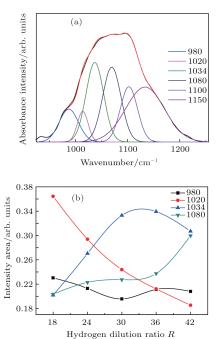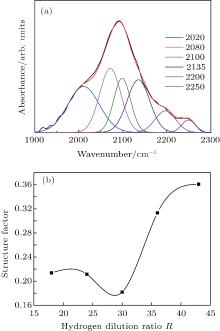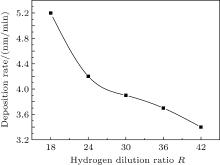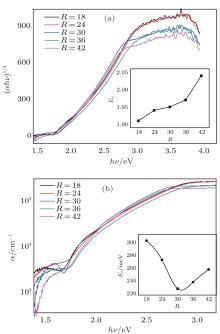†Corresponding author. E-mail: yuwei@hbu.edu.cn
*Project supported by the Key Basic Research Project of Hebei Province, China (Grant No. 12963930D) and the Natural Science Foundation of Hebei Province, China (Grant Nos. F2013201250 and B2012402011).
By using the plasma enhanced chemical vapor deposition (PECVD) technique, amorphous silicon oxide films containing nanocrystalline silicon grain (nc-SiO x:H) are deposited, and the bonding configurations and optical absorption properties of the films are investigated. The grain size can be well controlled by varying the hydrogen and oxygen content, and the largest size is obtained when the hydrogen dilution ratio R is 33. The results show that the crystallinity and the grain size of the film first increased and then decreased as R increased. The highest degree of crystallinity is obtained at R = 30. The analyses of bonding characteristics and light absorption characteristics show that the incorporation of hydrogen leads to an increase of overall bonding oxygen content in the film, and the film porosity first increases and then decreases. When R = 30, the film can be more compact, the optical absorption edge of the film is blue shifted, and the film has a lower activation energy.
As a promising material with appealing optical and electrical properties, nano-structured hydrogenated silicon oxide film has attracted recently remarkable attention. Nc-SiOx is a mixed-phase material consisting of a-SiOx and nanocrystal silicon. Compared with amorphous silicon, nc-SiOx has a wide band gap, low conductivity, and good stability. It has a broad application prospect in light emitting devices, photodetectors and photovoltaic devices and other fields.[1– 5] For the quantum confinement effect of nc-Si particles, the nc-SiOx films with different grain sizes of nc-Si can absorb different wavelengths of sunlight in photovoltaic devices. Therefore, the preparations and microstructures of nc-SiOx thin films have been studied in silica based high performance solar cell exploration.[6] However, the particle size and the surface bonding characteristics depend on high temperature diffusion process because most of the nc-SiOx thin films are prepared by high-temperature annealing technology.[7, 8] The post-annealing technology is incompatible with low temperature preparation technology of the Si-based thin film; therefore, the development of low temperature preparation technology of nc-SiOx films is the most important issue for photovoltaic application.
In recent years, by using the plasma enhanced chemical vapor deposition (PECVD) technique, low temperature preparation of microcrystalline silicon films can be realized through non-thermal equilibrium plasma activation of reactive gases and adjustment of the active hydrogen on the surface reaction.[9, 10] Compared with the growth process of microcrystalline silicon films, there are significant differences in the growth process of nc-SiOx films because the active particles in gas phase and the surface reactions contain oxygen elements.[11– 14] The hydrogen dilution ratio is one of the most important deposition parameters. It has significant influences on the microstructure and the optical properties of nc-SiOx films in the process of preparation of nc-SiOx films by PECVD technology. Hydrogen atoms can etch weak bonds and reduce the defect density in the thin film, which can increase the width of energy band gap of the film and change the characteristics of intermediate band gap states and band tail states. This will significantly change the energy level properties of the films.[15– 19] Since the self-organized growth of nc-Si particles is affected by oxidation and hydrogen flow can change the oxygen content in the films, we can control the grain size and microstructure of nc-Si film by adjusting hydrogen flow. To realize the control of the microstructure of nc-SiOx:H film by changing the hydrogen dilution ratio (the hydrogen dilution ratio refers to the ratio between the flows of hydrogen and silane), in the deposition process it is necessary to study the microstructures of the films with different hydrogen dilution ratios.
In this work, nc-SiOx thin films with different crystallization characteristics are deposited with different values of hydrogen dilution ratio R by PECVD technology. The microstructure, bonding characteristics and band structure properties of the films are analyzed. We especially study the variations of film bonding characteristics with oxygen content, and discuss the influences of microstructure change on energy band characteristics with different hydrogen dilution ratios.
The nc-SiOx:H films were deposited on P-type crystalline silicon (100) and quartz substrates at 350 ° C by radio frequency (13.56 MHz, 70 W) plasma enhanced chemical vapor deposition (PECVD) with SiH4, carbon dioxide (CO2) and hydrogen (H2) as the reaction gas. The silicon substrates were first immerged into the mixture of acetone and carbinol for 5 min, followed by the mixture of ammonia water and hydrogen peroxide, and they were finally dipped into the buffered hydrofluoric acid to remove the native silicon oxide from the surface of the substrate. The flow rates of SiH4 and CO2 were 3.3 sccm and 0.1 sccm, respectively. The hydrogen dilution ratio R was set to be 18, 24, 30, 36, and 42, respectively. The working pressure was 74 Pa. Different structures of the samples were obtained by changing the hydrogen dilution ratio R and the deposition time for each of all the samples was 110 min. To further removing the native silicon oxide and other impurities from the surface of the substrate, a hydrogen discharge was implemented for five minutes at the beginning of the film deposition process.
The x-ray diffraction (XRD) spectra were measured on Bruker D8 x-ray diffraction with Cu Kα radiation (40 kV, 40 mA). The bonding configuration and amounts of hydrogen and oxygen of the films could be characterized by Fourier transform infrared (FTIR) spectra measured by Bruker TENSOR27 from 400 cm− 1 to 4000 cm− 1 with a resolution of 4 cm− 1. The transmission spectra T and reflection spectra RI were measured by a Zolix SBP300 spectrometer. The T/(1 − RI) method was used to calculate the absorption spectra of the film, and the optical band gap of the film is calculated by the Tauc method.[20]
Figure 1 shows the experimental XRD spectra of nc- SiOx:H thin films with different values of hydrogen dilution ratioR. The XRD spectra show three Bragg diffraction peaks around 28.3° , 47.5° , and 55.9° , which correspond to the (111), (220), and (311) planes of crystalline silicon, respectively. With the increase of R, the film (111) diffraction peak intensity first increases and then decreases. The intensity of the XRD diffraction peak reaches the maximum at R = 30, indicating that the degree of crystallization is highest at this hydrogen dilution rate. The average grain size of the samples with different values of R can be calculated by the Scherrer formula[21]

where λ is the wavelength of x ray (0.1542 nm), B is the full width at half maximum (FWHM) of silicon (111) planes x ray, θ is the Bragg diffraction angle of crystalline silicon (111) planes, and k = 0.9 is the constant. The inset shows that the variation characteristics of the grain size change with R. It indicates that the silicon grains are nc-Si particles for a grain size below 6 nm. With the increase of R, the grain size of nc-Si first rapidly increases, and then decreases slowly after R = 33. Correspondingly, the diffraction peak position also shows a trend whereby it first rapidly increases and then tends to be stable.
 | Fig. 1. The XRD spectra of samples with different hydrogen dilution ratios. The inset shows the change of grain size with hydrogen dilution ratio of the sample. |
From our previous study on microcrystalline silicon films, we learned about the fact that hydrogen atoms in the plasma have multiple effects on the growth of a thin film. Hydrogen atoms can suspend the Si surface dangling bond and can carry out localized heating in the film surface, and they will produce surface bonding structure relaxation weak bond etching and active particle surface migration, etc.
The deposition rate shows a downward trend in Fig. 2, and the deposition rate decreases with hydrogen dilution ratio R increasing to 24, and then decreases slowly. The growth of thin film is in the range of nc-SiOx growth. Therefore, we have the following understanding of the film growth process. When the value of R is smaller, active particle bonds containing Si and O are connected to the surface to form a thin film, only a portion of the silicon-rich region is formed by nc-Si particles. As the hydrogen dilution ratio R increases, the suspension effect of enhanced dangling bonds of the silicon surface causes an increase in the surface mobility of silicon active particles, and then promotes the increase of phase segregation rate of nc-Si particles and SiOx, while increasing nc-Si grains and film crystallinity. Furthermore, the tensile strain of nc-Si grains has a rapid decrease due to the increased relaxation effect of nc-Si surface strain bond, which corresponds to rapid increase of the Si (111) diffraction peak value. In addition, enhanced etching effect leads to the increase of the etching rate of the film surface weak bonds, which can explain the reason why the film deposition rate decreases rapidly in a smaller R condition, as shown in Fig. 2. When the value of R is higher, high-energy hydrogen atoms of nc-Si boundary can etch most of Si– H and Si– Si weak bonds, for thin film etching effect is significantly enhanced. At the same time, the more O atoms embedded into the film increase the amorphous component in nc-SiOx:H film (SiOx), which makes the order degree of the film worse and the degree of crystallinity of the films lower (see Fig. 1).
The film bonding structure and change of H and O content in the film are analyzed by infrared absorption spectrum. Figure 3 shows the FTIR spectra of the nc-SiOx:H films. The Si– O absorption regions are located in a range of 450 cm− 1– 1300 cm− 1, including wagging modes in 550 cm− 1– 750 cm− 1 stretching modes in 550 cm− 1– 900 cm− 1. The bondedhydrogen content CH and bonded-oxygen content CO can be calculated by numerical integration from the Si– H wagging mode and the Si– O stretching mode by using the formula:[22, 23]

where ω and α (ω ) are the frequency of characteristic absorption peak and its corresponding absorption coefficient, respectively, NSi = 5 × 1022 cm− 3 is the atomic bonding density of crystal silicon, and AH = 1.6 × 1019 cm− 2, AO = 9.5 × 1018 cm− 2 are the bond density correction factors[24, 25] for Si– H and Si– O, respectively. The calculated results of CH and CO for different nc-SiOx:H films are plotted in Fig. 4.
Figure 4 shows that the CO gradually increases and the CH decreases gradually with the increase of R, which can be analyzed from the gas phase reaction and the surface reaction kinetics of the film. The results indicate that the active hydrogen atoms can adjust the structure of the nc-Si thin film. With the increase of hydrogen dilution ratio, lots of active hydrogen atoms are produced in the chamber. The hydrogen atoms which reach the growing surface of the film can promote surface complex reaction and etch the weak bonds of the surface.[26] This effect will be enhanced when R increases. In the process of deposition, the high-energy hydrogen atoms can passivate the dangling bonds, disconnect the weak Si– Si bonds and Si– H bonds in the films, benefiting the lattice relaxation and crystallization. Meanwhile, the etching effect of the hydrogen atoms gradually increases, the high-density hydrogen atoms can etch the most of Si– H bonds on the film surface. Thus, CH shows a decreasing trend. At the same time, with the increase of R, more hydrogen atoms are resolved into hydrogen ions, thereby increasing the decomposition of the more CO2 and then producing a lot of the OH radical group, so that more O atoms are embedded into the film. This shows that Co presents an up trend. Therefore, the change of Co in the film should be caused by the joint effect of the oxidation reaction and the growth of the film.
To gain more information about the influence of R on Si– O bonding structure in the film, figure 5(a) shows a multi peak Gauss fitting curve of the Si– O stretching mode peaks in 900 cm− 1– 1300 cm− 1, in which six different bonding configurations of oxide can be identified. The peaks centered at 980 cm− 1, 1012 cm− 1, 1034 cm− 1, and 1076 cm− 1 are related to the stretching vibration modes of HSi (Si2O), HSi (SiO2), HSi (O3), and Si (O4), respectively. The changes of peak integral intensity are shown in Fig. 5(b).
 | Fig. 5. (a) Multi peak fitting of Si– O stretching mode in the absorption spectrum of the film FITR, (b) variations of fitting peak integral intensity with hydrogen dilution ratio. |
During the experiment, R increases from 18 to 42. When R ≤ 24. It can be seen that the oxygen bonding structure exists in the form of nonstoichiometric H– Si (SiO2) in the film. With the increase of R, the structure component of H– Si (SiO2) decreases gradually, and the other three forms of structure components increase. These results are due to the joint effect that active H can etch weak bonds and enhance surface migration in plasma. Moreover, it can enhance the etching effect on weak Si– H and Si– Si bonds on the film surface, while enhancing the migration rate of Si atom, and making the Si atoms move to the most suitable bonding position. In this process, more oxygen atoms are bonded to the film, the sum of the bonding oxygen content reflects the change of the whole oxygen content. After R reaches 30, the etching effects of a large number of high energy active H atoms on film surface and the surface oxygen incursion are enhanced, which makes the degree of thin film crystallization decrease gradually. The relative ratio between H– Si (SiO3) phase and H– Si (O4) phase increases, which is accompanied by the increase of the whole oxygen content in the film.
Figure 6 shows the Gauss fitting of the Si– O stretching mode peaks in a range of 1900 cm− 1– 2300 cm− 1. Figure 6(a) shows that the Si– H stretching vibration absorption can be fitted by six different Gaussian peaks. The Gaussian peaks centered at 2020 cm− 1, and 2100 cm− 1 are related to the vibration absorptions[27] of SiH and SiH2 in amorphous silicon regions, respectively. The peaks centered at 2080 cm− 1, 2125 cm− 1, 2200 cm− 1, and 2250 cm− 1 correspond to the vibration absorptions[28] of SiH (SiH (Si2O)), SiH2 (SiH2 (SiO)), SiH (SiO2), and SiH (O3) in SiOx matrix, respectively. The quality of thin film can be evaluated by structural factor F = ISiH2/(ISiH + ISiH2).[26] The change curve of F with hydrogen dilution ratio is shown in Fig. 6(b). When R < 30, the structural factor F decreases gradually with the increase of R, and reaches the minimum value at R = 30, indicating the minimum film porosity and the best film densification. When R > 30, the structural factor F increases gradually with the increase of R, which indicates that the film porosity is improved and the film densification decreases. We believe that a small number of hydrogen atoms can be bonded with the dangling bonds in the film, reducing the density of dangling bonds in the film, so that the structure of the film becomes more orderly. However, with the increase of hydrogen dilution ratio R, the bombardment effect of the hydrogen ion increases, producing more pores and micropores in the inner regions of the thin film. Therefore, in the inner surface of pores and micropores more dangling bonds or weak Si– Si bonds may be produced, which would reduce the density and the degree of order of the film. The change of hydrogen content in the film will make the medium-range and short-range order of the film change accordingly. This further illustrates that the appropriate hydrogen dilution ratio R can improve the film order and can obtain a better performance film.
 | Fig. 6. (a) Multi-peak fitting of Si– H stretching mode in the absorption spectrum of the film FITR, (b) variation of structure factor F with hydrogen dilution ratio R. |
In the plasma region, the incorporation of hydrogen can etch dangling bonds and reduce the defect density in the film. At the same time, it will cause the film band tail to broaden, and will have an important influence on the microstructure and optical properties of the thin film. The relations between absorption coefficient of thin film and incident photon energy can be expressed by the following two equations, respectively:[28]


where B is a constant parameter, hν is the incident photon energy, and α is the optical absorption coefficient at the corresponding wavelength. Figure 7(a) shows the relation curves between (α hν )1/2 and hν in the nc-SiOx:H film, and the inset shows the variation of Eg with hydrogen dilution ratio R. It can be seen from Fig. 7(a) that as the hydrogen dilution ratio R increases, the optical band gap of the thin film exhibits a monotonic increase. This can be considered as the fact that the active hydrogen atoms can passivate the dangling bonds in the film, so that the defect density of the film decreases, thereby increasing the optical band gap. Moreover, the increase of R will also improve the incorporation probability of O atoms, thus causing the broadening of the optical band gap.
Figure 7(b) shows that the activation energy (Eu) first decreases and then increases as the hydrogen dilution ratio R increases, the activation energy decreases to a lowest point at R = 30, and then the disorder of the film reaches a minimum value. It can be considered as the case when R < 30, the degree of crystallization of thin films is lower, the defect density is higher, and the degree of disorder of the film is larger. With the increase of hydrogen dilution ratio R, the active hydrogen can passivate many dangling bonds in the film, so that both the defect density and the disorder of the film decrease, which is shown by the decrease of Eu value. When R > 30, the increase of H concentration makes more O atoms embed into the film, and it increases the oxygen content in the film. The enhancements of the surface chemical effect and strain effect make the interfacial microstructure of nc-Si particles more disordered, which can cause the film Eu to increase.
The above experimental results suggest that in the process of depositing nc-SiOx:H thin films, hydrogen can etch away the weak Si– Si bonds and passivate the dangling bonds in the film, reduce the defect state density of the film, and broaden the optical band gap of the film. Meanwhile, it can also effectively improve the incorporation probability of O atoms, which will have an important influence on optical properties of nc-SiOx:H thin film.
In our study, we realize low temperature preparations of nc-SiOx:H thin films by the PECVD technique and analyze the microstructures of the films at different hydrogen flow rates, bonding, and optical absorption characteristics, etc. We find the optimum hydrogen dilution ratio about SiOx thin film embedded with nc-Si particles of uniform particle size prepared at low temperature, and we also understand how to control the grain size effectively by adjusting the hydrogen dilution rate R. The results show that hydrogen plays a very important role in the film deposition process because hydrogen can passivate a large number of dangling bonds existing in the film and reduce the film defect density, thereby improving the structure of the film. As the hydrogen dilution ratio R increases, the peak intensity of XRD and the crystalline component of the film first increase and then decrease. The film has an obviously amorphous structure at R = 18, and the highest degree of crystallinity is obtained at R = 30. The optical band gap of the deposited film monotonically increases as R increases, while Eu energy first decreases and then increases, which shows that the disorder of the film first decreases and then increases. This is the result of the joint effect of hydrogen etching and the oxidation reaction in the film formation process. The experimental results show that the suitable hydrogen dilution ratio can effectively reduce the disorder of the film and realize the effective control of the nc-Si grain size, raise the film crystallinity, improve the films quality, contribute to the formation of nc-Si film with stable structure, and improve the photoelectric conversion efficiency of the thin film solar cells.
| 1 |
|
| 2 |
|
| 3 |
|
| 4 |
|
| 5 |
|
| 6 |
|
| 7 |
|
| 8 |
|
| 9 |
|
| 10 |
|
| 11 |
|
| 12 |
|
| 13 |
|
| 14 |
|
| 15 |
|
| 16 |
|
| 17 |
|
| 18 |
|
| 19 |
|
| 20 |
|
| 21 |
|
| 22 |
|
| 23 |
|
| 24 |
|
| 25 |
|
| 26 |
|
| 27 |
|
| 28 |
|






